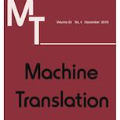We introduce the task of isochrony-aware machine translation which aims at generating translations suitable for dubbing. Dubbing of a spoken sentence requires transferring the content as well as the speech-pause structure of the source into the target language to achieve audiovisual coherence. Practically, this implies correctly projecting pauses from the source to the target and ensuring that target speech segments have roughly the same duration of the corresponding source speech segments. In this work, we propose implicit and explicit modeling approaches to integrate isochrony information into neural machine translation. Experiments on English-German/French language pairs with automatic metrics show that the simplest of the considered approaches works best. Results are confirmed by human evaluations of translations and dubbed videos.
翻译:我们引入了以产生适合调试的译文为目的的偏差感觉机器翻译的任务。 调试一个口语句需要将内容以及源的语音-调制结构转换成目标语言,以实现视听一致性。 实际地,这意味着正确预测源到目标的暂停,并确保目标演讲部分大致与相应的源演讲部分的长度大致相同。 在这项工作中,我们提出了将异差信息纳入神经机翻译的隐含和明确的模型化方法。 对英德/法两种语言配对的自动度量的实验显示,最简单的方法最有效。结果得到翻译和假录制视频的人类评价的证实。




